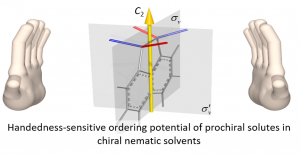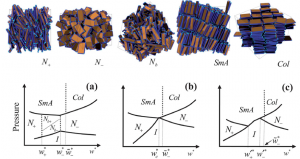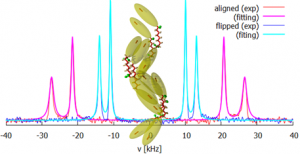AG Vanakaras, DJ Photinos, Liquid Crystals 45 (13-15), 2184-2196, (2018).
 Abstract: Molecular dynamics simulations of selected members of the cyano-biphenyl (CB) series of dimers (CBnCB) have been set up using atomistic detail for the description of the alkyl spacer and coarse-grained representation of the CB end-segments. Detailed results are presented for the CB7CB dimers, showing an isotropic fluid phase and two nematic phases. The positional and orientational correlation functions extracted from the simulations are used to elucidate the structure of the low-temperature nematic phase. Polar molecular ordering is clearly identified along a direction undergoing helical twisting at right angles to the helical axis, with a constant pitch of about of 8 nm. The local ordering of the various molecular segments is calculated and found to be in excellent agreement with experimental NMR measurements. Key findings of the simulation are shown to be correctly predicted by the theoretical model of the polar-twisted nematic (NPT) phase [A.G. Vanakaras, D.J. Photinos, Soft Matter. 12 (2016) 2208–2220]. The complete failure of the usual twist bend model (NTB) to account for these findings is demonstrated.
Abstract: Molecular dynamics simulations of selected members of the cyano-biphenyl (CB) series of dimers (CBnCB) have been set up using atomistic detail for the description of the alkyl spacer and coarse-grained representation of the CB end-segments. Detailed results are presented for the CB7CB dimers, showing an isotropic fluid phase and two nematic phases. The positional and orientational correlation functions extracted from the simulations are used to elucidate the structure of the low-temperature nematic phase. Polar molecular ordering is clearly identified along a direction undergoing helical twisting at right angles to the helical axis, with a constant pitch of about of 8 nm. The local ordering of the various molecular segments is calculated and found to be in excellent agreement with experimental NMR measurements. Key findings of the simulation are shown to be correctly predicted by the theoretical model of the polar-twisted nematic (NPT) phase [A.G. Vanakaras, D.J. Photinos, Soft Matter. 12 (2016) 2208–2220]. The complete failure of the usual twist bend model (NTB) to account for these findings is demonstrated.
A. Kumar, A. G. Vanakaras, D. J. Photinos, J. Phys. Chem. B, 121(47), 10689-10703 (2017).
Abstract The potential of mean torque governing the orientational ordering of prochiral solutes in the two nematic phases (N and NX) formed by certain classes of symmetric achiral bimesogens is formulated and used for the analysis of existing NMR measurements on solutes of various symmetries dissolved in the two phases. Three distinct attributes of the solvent phase, namely polarity of the orientational ordering, chirality of the constituent molecules, and spatial modulation of the local director, are identified as underlying three possible mechanisms for the generation of chiral asymmetry in the low temperature nematic phase (NX). The role and quantitative contribution of each mechanism to enantiotopic discrimination in the NX phase are presented and compared with the case of the conventional chiral nematic phase (N*). It is found that polar ordering is essential for the appearance of enantiotopic discrimination in small rigid solutes dissolved in the NX phase and that such discrimination is restricted to solutes belonging to the point group symmetries Cs and C2v.
Anant Kumar, Alexandros G. Vanakaras and Demetri J. Photinos, J. Phys. Chem. B, Article ASAP DOI: 10.1021/acs.jpcb.6b07404
ABSTRACT: We have developed a molecular theory for enantiotopic discrimination in prochiral solutes dissolved in chiral nematic solvents by means of NM R spectroscopy. The leading rank tensor contributions to the proposed potential of mean torque include symmetric as well as antisymmetric terms with respect to spatial inversion; these lead to consistent determination of all prochiral solute symmetries for which enantiotopes are distinguishable by NMR and also to excellent quantitative agreement when tested against the available experimental data for the rigid solutes acenaphthene and norbornene as well as for the moderately flexible ethanol molecule.
R spectroscopy. The leading rank tensor contributions to the proposed potential of mean torque include symmetric as well as antisymmetric terms with respect to spatial inversion; these lead to consistent determination of all prochiral solute symmetries for which enantiotopes are distinguishable by NMR and also to excellent quantitative agreement when tested against the available experimental data for the rigid solutes acenaphthene and norbornene as well as for the moderately flexible ethanol molecule.
Alexandros G. Vanakaras and Demetri J. Photinos
Soft Matter, 2016, DOI: 10.1039/C5SM02505B (Download)
We study theoretically the molecular origins of the fascinating, and still debated, nematic–nematic phase transition exhibited by symmetric, statistically achiral, mesogenic dimers. A simple molecular model that mimics the key features and symmetry (C2V) of this class of mesogens is presented. In the mean-field approximation, the model yields up to three positionally disordered phases, one isotropic and two nematic. The low temperature nematic phase (NX) has a local two-fold symmetry axis, which is also a direction of molecular polar ordering and is tightly twisted about a macroscopic phase axis. The onset of polar ordering generates spontaneous chiral symmetry breaking and the formation of chiral domains of opposite handedness, manifested primarily by the twisting of the polar director. Within these domains the statistical balance between the enantiomer conformations is slightly shifted and the principal axes of the ordering tensors of the molecular segments twist at constant tilt angles with the helical axis. Key experimental results on the NX phase of liquid crystalline dimers are discussed in the light of the theoretical predictions of the model, which are also contrasted with the predictions of the twist-bend nematic model.
Zerihun G. Workineh and Alexandros G. Vanakaras, Polymers 2014, 6(8), 2082-2099; doi:10.3390/polym6082082
 Abstract: The surface alignment of liquid crystalline dendrimers (LCDrs) is a key factor for many of their potential applications. Here, we present results from Monte Carlo simulations of LCDrs adsorbed on flat, impenetrable aligning substrates. A tractable coarse-grained force field for the inter-dendritic and the dendrimer-substrate interactions is introduced. We investigate the conformational and ordering properties of single, end-functionalized LCDrs under homeotropic, random (or degenerate) planar and unidirectional planar aligning substrates. Depending on the anchoring constrains to the mesogenic units of the LCDr and on temperature, a variety of stable ordered LCDr states, differing in their topology, are observed and analyzed. The influence of the dendritic generation and core functionality on the surface-induced ordering of the LCDrs are examined.
Abstract: The surface alignment of liquid crystalline dendrimers (LCDrs) is a key factor for many of their potential applications. Here, we present results from Monte Carlo simulations of LCDrs adsorbed on flat, impenetrable aligning substrates. A tractable coarse-grained force field for the inter-dendritic and the dendrimer-substrate interactions is introduced. We investigate the conformational and ordering properties of single, end-functionalized LCDrs under homeotropic, random (or degenerate) planar and unidirectional planar aligning substrates. Depending on the anchoring constrains to the mesogenic units of the LCDr and on temperature, a variety of stable ordered LCDr states, differing in their topology, are observed and analyzed. The influence of the dendritic generation and core functionality on the surface-induced ordering of the LCDrs are examined.
Keywords: liquid crystal dendrimers; surface alignment; Monte Carlo simulations; surface confinement of dendrimer
Anke Hoffmann, Alexandros G. Vanakaras, Alexandra Kohlmeier, Georg H. Mehl, Demetri J. Photinos, arXiv:1401.5445 [cond-Mat]. (2014). http://arxiv.org/abs/1401.5445.
Abstract: NMR measurements on a selectively deuteriated liquid crystal dimer CB-C9-CB exhibiting two nematic phases show that the molecules in the lower temperature nematic phase, Nx, experience a chiral environment and are ordered about a unique direction. The results are contrasted with previous reports that proposed a twist-bend spatial variation of the director. A structural model is proposed wherein the molecules show organization into highly correlated assemblies of opposite chirality.
Stavros D. Peroukidis, Alexandros G. Vanakaras, S. D. Peroukidis, A G. Vanakaras, Soft Mater, 9, 7419-7423 (2013). DOI: 10.1039/C3SM51165K.
The rich mesophase polymorhism and the phase sequence of board-like colloids depends critically on their shape anisometry. Implementing  extensive Monte Carlo simulations, we calculated the full phase diagram of sterically interacting board-like particles, for a range of experimentally accessible molecular dimensions/anisometries of colloids of this shape. A variety of self organized mesophases including uniaxial and biaxial nematics, smectic, cubatic and columnar phases have been identified. Our results demonstrate clearly that the molecular anisometry influences critically not only the structure and the symmetry of the mesophases but also, and perhaps more interestingly, the phase sequence among them. New classes of phase sequences such as nematic-nematic and, for the first time, a direct transition from a discotic and a biaxial nematic to an orthogonal smectic A phase have been identified. The molecular geometry requirements for such a phase behavior have been located.
extensive Monte Carlo simulations, we calculated the full phase diagram of sterically interacting board-like particles, for a range of experimentally accessible molecular dimensions/anisometries of colloids of this shape. A variety of self organized mesophases including uniaxial and biaxial nematics, smectic, cubatic and columnar phases have been identified. Our results demonstrate clearly that the molecular anisometry influences critically not only the structure and the symmetry of the mesophases but also, and perhaps more interestingly, the phase sequence among them. New classes of phase sequences such as nematic-nematic and, for the first time, a direct transition from a discotic and a biaxial nematic to an orthogonal smectic A phase have been identified. The molecular geometry requirements for such a phase behavior have been located.

The purpose of this biennial conference is to bring together the research community working in the interdisciplinary field of Liquid Crystals and soft anisotropic materials. The conference will be held from September 22-27, 2013 in the Paradise Mare Hotel, a five star resort, in Rhodes, Greece.
Please visit the web page of the conference: http://eclc2013.upatras.gr
The organizing committee:
- George Floudas, University of Ioannina
- Panayota K. Karahaliou, University of Patras
- Emmanouil Kriezis, University of Thessaloniki
- Polykarpos Pissis, NTUA
- Dimitris Tsiourvas, N.C.S.R “Demokritos”
- Stavros Peroukidis, University of Patras
V. Yannopapas, N. Fyttas, V. Kyrimi, E. Kallos, A.G. Vanakaras, D.J. Photinos, PSSA, DOI: 10.1002/pssa.201228489.
We study the optical properties of gold nanoparticles (NPs) coated with a nematic liquid crystal (NLC) whose director field is distributed around the NP according to the anchoring conditions at the surface of the NP. The distribution of the NLC is obtained by minimization of the corresponding Frank free-energy functional whilst the optical response is calculated by the discrete-dipole approximation (DDA). We find, in particular, that the anisotropy of the NLC coating does not affect much the (isotropic) optical response of the NP. However, for strong anchoring of the NLC molecules on the surface of NP, the inhomogeneity of the coating which is manifested by a ring-type singularity (disclination or Saturn ring), produces an enhancement of the extinction cross spectrum over the entire visible spectrum.
 Abstract: Molecular dynamics simulations of selected members of the cyano-biphenyl (CB) series of dimers (CBnCB) have been set up using atomistic detail for the description of the alkyl spacer and coarse-grained representation of the CB end-segments. Detailed results are presented for the CB7CB dimers, showing an isotropic fluid phase and two nematic phases. The positional and orientational correlation functions extracted from the simulations are used to elucidate the structure of the low-temperature nematic phase. Polar molecular ordering is clearly identified along a direction undergoing helical twisting at right angles to the helical axis, with a constant pitch of about of 8 nm. The local ordering of the various molecular segments is calculated and found to be in excellent agreement with experimental NMR measurements. Key findings of the simulation are shown to be correctly predicted by the theoretical model of the polar-twisted nematic (NPT) phase [A.G. Vanakaras, D.J. Photinos, Soft Matter. 12 (2016) 2208–2220]. The complete failure of the usual twist bend model (NTB) to account for these findings is demonstrated.
Abstract: Molecular dynamics simulations of selected members of the cyano-biphenyl (CB) series of dimers (CBnCB) have been set up using atomistic detail for the description of the alkyl spacer and coarse-grained representation of the CB end-segments. Detailed results are presented for the CB7CB dimers, showing an isotropic fluid phase and two nematic phases. The positional and orientational correlation functions extracted from the simulations are used to elucidate the structure of the low-temperature nematic phase. Polar molecular ordering is clearly identified along a direction undergoing helical twisting at right angles to the helical axis, with a constant pitch of about of 8 nm. The local ordering of the various molecular segments is calculated and found to be in excellent agreement with experimental NMR measurements. Key findings of the simulation are shown to be correctly predicted by the theoretical model of the polar-twisted nematic (NPT) phase [A.G. Vanakaras, D.J. Photinos, Soft Matter. 12 (2016) 2208–2220]. The complete failure of the usual twist bend model (NTB) to account for these findings is demonstrated.


